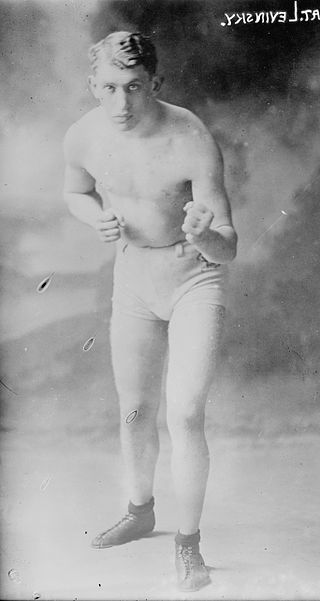Battling Levinsky Wins First Title
No one took advantage of the No Decision era of professional boxing like Battling Levinsky. Levinsky was a skilled defensive boxer, who took little damage during his fights. When Ring Magazine asked him why he was so active, sometimes taking 3 fights in a day around New York, Levinsky said, “I like money and I never get hurt.”
Levinsky was born Barney Lebowitz on June 10, 1891 in Philadelphia, Pennsylvania. He chose the ring name “Battling Levinsky” to hide his profession from his parents, who did not approve of him boxing.

Photo of Barney Lebrowitz aka Battling Levinsky (Public Domain)
Levinsky kept a job during the early part of his career. He only boxed in the evening and on weekends until he won the World Championship. At that point, newspaper coverage made it impossible for him to hide his professional boxing career from his parents.
Levinsky fought over a 170 fights in the first six years of his career. In his 174th fight, Levinsky fought Jack Dillon for a version of the light heavyweight boxing championship on October 24, 1916. The bout took place at the Armory in Boston, Massachusetts.
Dillon was the slight betting favorite as he was the harder puncher, while Levinsky was considered the master boxer. The bout was scheduled for 12 rounds, standard for today but much shorter than the normal 20-round bout of the time. If neither man could stop the other, the referee would decide the winner.
Both men weighed 182 pounds but Levinsky was taller. Levinsky also had a noticeable reach advantage.
Referee Larry Conly brought the men to the center ring for the customary handshake. He then signaled for the bout to begin.
In the first round, the men set out their strategies for the fight. Dillon relied on a body attack to setup head punches, most of which missed Levinsky. Levinsky used a jab to the face to setup his offense. Levinsky scored time and again with a left jab and left hook combination.
While Dillon missed with most of his head shots, the body attack seemed to tire Levinsky in the third round. Levinsky got a second wind in the fourth round and worked over Dillon’s body as well.
The fifth round provided the most action. Levinsky continuously struck Dillon with left hands to the face and body. Dillon finally scored some head punches to go along with his body attack. Both men struck freely and the fans really got into the action.
While the fans were expecting an exciting battle, the sixth round marked a change in the fight. While Dillon continued to strike to the body, he appeared to have damaged his hands. Dillon wasn’t hitting as freely and was also visibly tiring. The shock of the hand injuries could also have been responsible for Dillon’s reduced offense.
Levinsky continued to use his left jab and left hook to great effect. From the seventh round on, it was a one-sided fight in Levinsky’s favor. When the referee raised Levinsky’s hand after the twelfth round to signify his win, there were no complaints from the fans or Dillon. Levinsky clearly won the bout and title.
Levinsky fought at least 289 fights in his 20 year career. In his last fight at 40 years of age, Levinsky scored a technical knockout on his opponent in the third round. Unlike a lot of fighters, who stayed too long, Levinsky went out on a win. In a Ring Magazine poll, he was rated the 9th best light heavyweight of all-time.
You can leave a comment or ask a question about this or any post on my Facebook page or Twitter profile.
Sources: Ring: Boxing in the 20th Century by Stanley Weston (1993) and The Boston Globe, October 25, 1916 edition, p. 7

